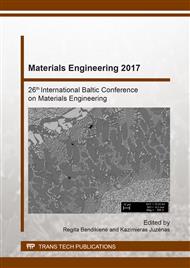p.151
p.157
p.162
p.167
p.172
p.177
p.185
p.190
p.195
Extraction and Characterization of Collagen Obtained from Collagen-Containing Wastes of the Leather Industry
Abstract:
The study presents the extraction of collagen, a product of high value, from fleshings form hides. After testing several collagen extraction procedures we have proposed the simple and effective method to extract collagen from collagen-containing wastes of the leather industry. The unified method is based on the extraction of collagen using acetic acid in the presence of EDTA and included two repeated extraction stages. Qualitative analysis of the collagen using the disk-electrophoresis method showed a different ratio of monomers, dimers and other proteins.
Info:
Periodical:
Pages:
172-176
Citation:
Online since:
October 2017
Keywords:
Price:
Сopyright:
© 2017 Trans Tech Publications Ltd. All Rights Reserved
Share:
Citation:


